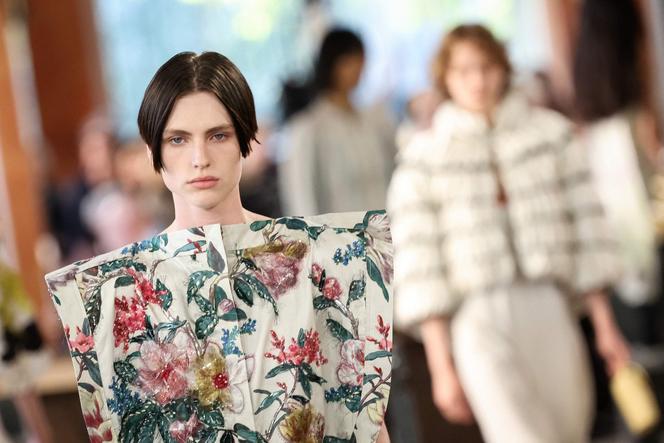


Fashion insiders had been waiting for months, and it has finally arrived: The Spring-Summer 2026 season Paris Fashion Week, running from September 29 to October 7, stands out for the sheer number of presentations and runway shows scheduled – 111 on the official calendar, a record not seen since 2019, and a total that doesn't include events that haven't received official recognition by the Federation of Haute Couture and Fashion (FHCM). Another distinctive feature: no fewer than eight houses were set to present their new artistic directors' first shows.
The most anticipated debuts are undoubtedly those of Jonathan Anderson for Dior, on October 1, and Matthieu Blazy at Chanel, scheduled for five days later. In between, audiences will witness the first collections by Pierpaolo Piccioli for Balenciaga, Lazaro Hernandez and Jack McCollough for Loewe, Duran Lantink for Jean Paul Gaultier, Glenn Martens for Maison Margiela, Mark Thomas for Carven and Miguel Castro Freitas for Mugler.
While waiting to see what these men (as it appears no women were included in this major round of appointments) have proposed, September 30 was punctuated by shows from artistic directors who, boosted by their long service with their brands, sought to distinguish themselves by pushing experimentation even further.
Nicolas Ghesquière remains the master of this art. The designer, who has run Louis Vuitton's womenswear line for 12 years, took over the Louvre. Indeed, most of his shows are held there, except when he alternates with the Musée d'Orsay, as both institutions benefit from the patronage of LVMH, which owns the brand. That day, as the museum was closed for its regular weekly day off, the guests enjoyed an unobstructed view of the Winged Victory of Samothrace before taking their seats in Queen Anne of Austria's erstwhile summer apartments, which were designed by architect Louis Le Vau in the 17th century and recently restored.
The vestibule, the antechamber, the small salon, the bath chamber: Every space gleamed, with ceilings adorned in gold leaf, polychromatic marble floors from the Second Empire era and red walls dating back to the 1930s. The sense of temporal dissonance was heightened by the addition of artworks and furnishings drawn from periods ranging from the 17th century through to the 1980s – the ideal backdrop for a collection that also blurred the lines.
"The starting point is about celebrating intimacy, the act of dressing for oneself, at home. It's an inner journey through an apartment," said Ghesquière. His looks combined ideas, styles and materials to form a hybrid ensemble, with no clear markers. There was a jacket made from fragments of bas-reliefs; a long, furry vest covered in multicolored stones; a cut-off corset top, trimmed with a ruff that unfurled over the arms; a curtain-like two-material sweater with a funnel neck; and more. At this point, it was not far from being fundamental research.
At Courrèges, Nicolas Di Felice marked his fifth anniversary as artistic director of the house, to which he has restored a sexy vitality. As statuesque models walked through the Carreau du Temple venue, amid a white, circular set flooded with blinding light, a countdown began, ticking up rising temperatures noted in degrees. "With the 10 seasonal minutes allotted to me, I'm not trying to deliver an intellectualized message, but an experience: This time, I wanted to capture the dazzling effect of the sun," said Di Felice, a designer in his 40s.
Two-in-one swimsuit-style dresses, short and slit wrap skirts, jackets with open sleeves to allow bare arms to go free, tank tops that let air flow between fabric and skin, '60s-style boots made of ultra-thin jersey: With a palette ranging from pool blue to sand, everything was designed for lightness and freedom of movement. This functional wardrobe, designed for a world on fire, also gave rise to edgier silhouettes, with caps adorned with long veils that shield the eyes, or sleeveless dresses built around a framework, in a way similar to sunshades, with panels covering half the face. "Keeping a technical and experimental dimension is stimulating for the teams: I owe it to this house," said Di Felice.
For Stella McCartney, who founded her label in 2001, the past year was marked by buying back its shares from the luxury giant LVMH, making her company independent once again. This means it is freer, but also more vulnerable on the market. In a show in the lobby of the Centre Pompidou museum, held in front of a host of stars (Helen Mirren, Robin Wright, etc.), she remained true to her vision of an independent woman. Double-breasted suits with wide-legged pants, pleated mini-dresses with trains, cargo pants or men's shirts adorned with ruffles: The collection was presented to the tune of "Come Together," the hit song by The Beatles. "John's song," as she called it backstage, not needing to mention Lennon by name.
The daughter of "Paul," who, for her ready-to-wear collections uses "no leather, no feathers, no fur, no exotic skins," has not sacrificed innovation. Alongside algae or recycled bioplastic-based sequins, this season she experimented with raffia cut into strips for short, spherical dresses – which were not always flattering – or trompe-l'oeil feathers that formed convincing swimsuits or a sheath dress. "They're actually strands of plant fiber, embroidered and naturally dyed," McCartney said. The illusion worked. "We all have to wake up, to think more about the origins of the materials we wear," she added. "Experimenting doesn't mean giving up your love of fashion." Quite the contrary.
Translation of an original article published in French on lemonde.fr; the publisher may only be liable for the French version.
